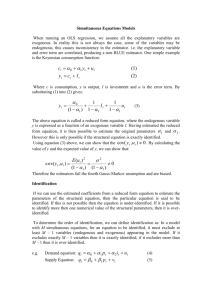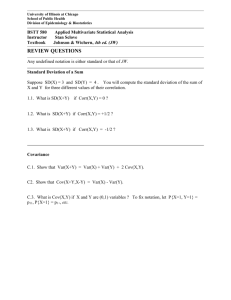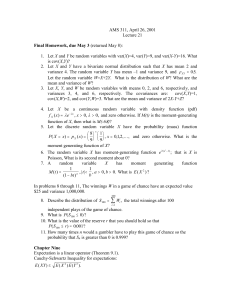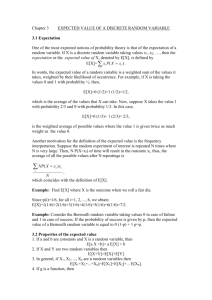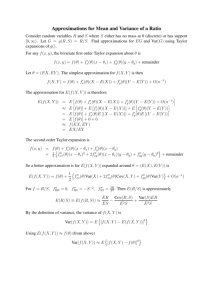Lecture 3: Introduction to path analysis
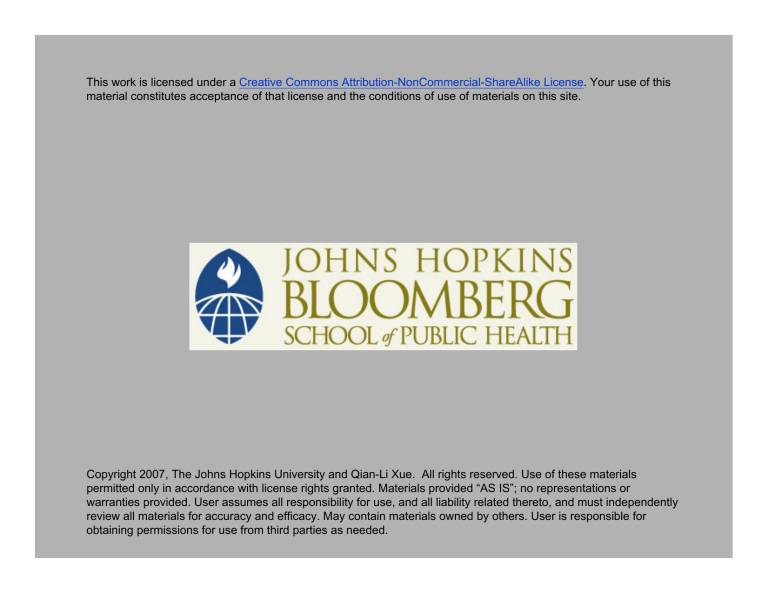
This work is licensed under a Creative Commons Attribution-NonCommercial-ShareAlike License . Your use of this material constitutes acceptance of that license and the conditions of use of materials on this site.
Copyright 2007, The Johns Hopkins University and Qian-Li Xue. All rights reserved. Use of these materials permitted only in accordance with license rights granted. Materials provided “AS IS”; no representations or warranties provided. User assumes all responsibility for use, and all liability related thereto, and must independently review all materials for accuracy and efficacy. May contain materials owned by others. User is responsible for obtaining permissions for use from third parties as needed.
Introduction to Path Analysis
Statistics for Psychosocial Research II:
Structural Models
Qian-Li Xue
Outline
Key components of path analysis
Path Diagrams
Decomposing covariances and correlations
Direct, Indirect, and Total Effects
Parameter estimation
Model identification
Model fit statistics
The origin of SEM
Swell Wright, a geneticist in 1920s, attempted to solve simultaneous equations to disentangle genetic influences across generations (“path analysis”)
Gained popularity in 1960, when Blalock,
Duncan, and others introduced them to social science (e.g. status attainment processes)
The development of general linear models by
Joreskog and others in 1970s (“LISREL” models, i.e. linear structural relations)
Difference between path analysis and structural equation modeling (SEM)
Path analysis is a special case of SEM
Path analysis contains only observed variables and each variable only has one indicator
Path analysis assumes that all variables are measured without error
SEM uses latent variables to account for measurement error
Path analysis has a more restrictive set of assumptions than SEM (e.g. no correlation between the error terms)
Most of the models that you will see in the literature are
SEM rather than path analyses
Path Diagram
Path diagrams: pictorial representations of associations (Sewell Wright, 1920s)
Key characteristics:
As developed by Wright, refer to models that are linear in the parameters (but they can be nonlinear in the variables)
Exogenous variables: their causes lie outside the model
Endogenous variables: determined by variables within the model
May or may not include latent variables
for now, we will focus on models with only manifest
(observed) variables, and will introduce latent variables in the next lecture.
Regression Example
Standard equation format for a regression equation:
Y
1
= α + γ
11
X
1
+ γ
12
X
2
+ γ
13
X
3
+ γ
14
X
4
+ γ
15
X
5
+ γ
16
X
6
+ ζ
1
x
3 x
4 x
1 x
2 x
5 x
6
Regression Example
Y
1
Regression Example
x
3 x
4 x
5 x
6 x
1 x
2
Y
1
ζ
1
Regression Example
x
1 x
2 x
3 x
4 x
5 x
6
Y
1
ζ
1
Path Diagram: Common Notation
x
1
Yrs of work
Age
ζ
2
ζ
3 y
2
Labor activism y
3 sentiment
Union Sentiment Example
(McDonald and Clelland, 1984) x
2 ζ
1 y
1 Deference to managers
Noncausal associations between exogenous variables indicated by two-headed arrows
Causal associations represented by unidirectional arrows extended from each determining variable to each variable dependent on it
Residual variables are represented by unidirectional arrows leading from the residual variable to the dependent variable
Path Diagram: Common Notation
Gamma ( γ ): Coefficient of association between an exogenous and endogenous variable
Beta ( β ): Coefficient of association between two endogenous variables
Zeta ( ζ ): Error term for endogenous variable
Subscript protocol: first number refers to the
‘destination’ variable, while second number refers to the ‘origination’ variable.
ζ
1
ζ
2 x1
γ
11 y1
β
21 y2 x2 γ
12
Path Diagram: Rules and
Assumptions
Endogenous variables are never connected by curved arrows
Residual arrows point at endogenous variables, but not exogenous variables
Causes are unitary (except for residuals)
Causal relationships are linear
Path Model: Mediation
x
1 x
2 x
3 x
4 x
5 x
6
ζ
1
Y
1
ζ
2
Y
2
Y
3
ζ
3
Y
4
ζ
4
Path Diagram
Can you depict a path diagram for this system of equations?
y
1
= γ
11 x
1
+ γ
12 x
2
+ β
12 y
2
+ ζ
1 y
2
= γ
21 x
1
+ γ
22 x
2
+ β
21 y
1
+ ζ
2
How about this one?
Path Diagram
y
1
= γ
12 x
2
+ β
12 y
2
+ ζ
1 y
2
= γ
21 x
1
+ γ
22 x
2
+ ζ
2 y
3
= γ
31 x
1
+ γ
32 x
2
+ β
31 y
1
+ β
32 y
2
+ ζ
3
Wright’s Rules for Calculating Total Association
Total association: simple correlation between x and y
For a proper path diagram, the correlation between any two variables = sum of the compound paths connecting the two variables
Wright’s Rule for a compound path:
1) no loops
2) no going forward then backward
3) a maximum of one curved arrow per path
Example: compound path
(Loehlin, page 9, Fig. 1.6)
ζ d
A
ζ c
D
C
(a)
B A
E ζ e
ζ b
B C ζ c
D ζ d
(b)
A
D
B C
ζ d
E
ζ e
(c)
F
ζ f
Total Association: Calculation
h
A f
B g
C a b
D c
ζ d d
ζ e
ζ f
E e
F
Loehlin, page 10,
Fig. 1.7
What is correlation between A and D?
What is correlation between A and E?
What is correlation between A and F?
What is correlation between B and F?
a+fb ad+fbd+hc ade+fbde+hce gce+fade+bde
Direct, Indirect, and Total Effects
Path analysis distinguishes three types of effects:
Direct effects: association of one variable with another net of the indirect paths specified in the model
Indirect effects:
association of one variable with another mediated through other variables in the model
computed as the product of paths linking variables
Total effect: direct effect plus indirect effect(s)
Note: the decomposition of effects always is modeldependent!!!
Direct, Indirect, and Total Effects
Example:
Does association of education with adult depression represent the influence of contemporaneous social stressors?
E.g., unemployment, divorce, etc.
Every longitudinal study shows that education affects depression, but not vice-versa
Use data from the National Child Development
Survey, which assessed a birth cohort of about
10,000 individuals for depression at age 23, 33, and
43.
Direct, Indirect, and Total Effects:
Example
dep23
1 e1
.47
-.29
.50
.25
-.08
.24
dep33
1 e2
.34
-.01
.46
dep43
1 e3
.37
Direct, Indirect, and Total Effects:
Example
.25
-.29
-.08
.24
dep23
1 e1
.47
.50
dep33
1 e2
.34
“schyrs21” on “dep33”:
Direct effect = -0.08
Indirect effect = -0.29*0.50 =-0.145
Total effect = -0.08+(-0.29*0.50 )
-.01
.46
dep43
1 e3
.37
What is the indirect effects of
“schyrs21” on “dep43”?
Path Analysis
Key assumptions of path analysis:
E( ζ i)=0: mean value of disturbance term is 0
cov( ζ i
, ζ j
)=0: no autocorrelation between the disturbance terms
var( ζ i
|X i
)= σ 2
cov( ζ i
,X i
)=0
The Fundamental hypothesis for SEM
“The covariance matrix of the observed variables is a function of a set of parameters (of the model)” (Bollen)
If the model is correct and parameters are known:
Σ = Σ ( θ ) where Σ is the population covariance matrix of observed variables; Σ ( θ ) is the model-based covariance matrix written as a function of θ
λ
11
X
1
δ
1
Covariances
λ
21
ξ
1
λ
31
Decomposition of
λ
41
and Correlations
X
X
X
X
1
2
3
4
=
=
=
=
λ
11
ξ
1
λ
21
ξ
1
λ
31
ξ
1
λ
41
ξ
1
+ δ
1
+
+
δ
2
δ
3
+ δ
4
X
2
δ
2
X
3
δ
3
X
4
δ
4 or in matrix notation :
X
E( δ
=
)
Λ x
ξ
=
+ δ
0, Var( ξ ) and Cov( ξ , δ ) = 0
= Φ , Var( δ ) = Θ
δ
, cov( X
1
, X
4
)
= λ
11
λ
41 ϕ
11
, where ϕ
11
=
= cov( var( ξ
1
)
λ
11
ξ
1
+ δ
1
, λ
41
ξ
1
+ δ
4
)
λ
11
X
1
δ
1
Decomposition of
Covariances and Correlations
λ
21
X
2
δ
2
ξ
1
λ
31
X
3
δ
3
λ
41
X
4
δ
4
X
= Λ x
ξ
Cov
(
X
) =
+ δ
Σ =
E
(
X X
′ )
=
X X
(
Λ
′
= Λ
= x
ξ
(
Λ
+ δ x
ξ
)( ξ
+ δ
′ Λ′ x
)(
Λ
+ x
δ
ξ
′ )
+ x
ξ ξ ′ Λ′ x
+ Λ x
ξ δ ′ + δ ξ
δ
′ Λ′ x
′ )
Σ =
E
(
X X
′ ) = Λ x
Φ Λ′ x
+ Θ
δ
+ δ δ ′
Covariance matrix of ξ
Covariance matrix of δ
Path Model: Estimation
Model hypothesis: Σ = Σ ( θ )
But, we don’t observe Σ , instead, we have sample covariance matrix of the observed variables: S
Estimation of Path Models:
∧ ∧
Choose θ so that Σ ( θ ) is close to S
Path Model: Estimation
1) Solve system of equations
X
1
γ
11
Y
1
β
21
Y
2 Y1 = γ 11X1 + ζ 1
Y2 = β 21Y1 + ζ 2
ζ
1 a) Using covariance algebra
Σ
ζ
2
Σ ( θ ) var(Y
1
) γ
11
2 var(X
1
) + var( ζ
1
) cov(Y
2
,Y
1
) var(Y
2
) cov(X
1
,Y
1
) cov(X
1
,Y
2
) var(X
1
)
= β
21
( γ
11
2 var(X
1
) + var( ζ
1
))
γ
11 var(X
1
)
β
21
2 ( γ
11
2 var(X
1
) + var( ζ
1
)) + var( ζ
2
)
β
21
γ
11 var(X
1
) var(X
1
)
Path Model: Estimation
1) Solve system of equations
X
1
γ
11
Y
1
β
21
Y
2 Y1 = γ 11X1 + ζ 1
Y2 = β 21Y1 + ζ 2
ζ
1
ζ
2 b) Using Wright’s rules based on correlation matrix
Σ
Σ ( θ )
1 cor(Y
2
,Y
1
) 1 cor(X
1
,Y
1
) cor(X
1
,Y
2
) 1
=
1
β
21
γ
11
1
β
21
γ
11
1
Path Model: Estimation
2) Write a computer program to estimate every single possible combination of parameters possible, and see which fits best (i.e. minimize a discrepancy function of SΣ ( θ ) evaluated at θ )
3) Use an iterative procedure (See Figure 2.2 on page 38 of
Loehlin’s Latent Variable Models )
Model Identification
Identification: A model is identified if is theoretically possible to estimate one and only one set of parameters. Three helpful rules for path diagrams:
“t-rule”
necessary, but not sufficient rule
the number of unknown parameters to be solved for cannot exceed the number of observed variances and covariances to be fitted
analogous to needing an equation for each parameter
number of parameters to be estimated: variances of exogenous variables, variances of errors for endogenous variables, direct effects, and double-headed arrows
number of variances and covariances, computed as: n(n+1)/2, where n is the number of observed exogenous and endogenous variables
Model Identification
Just identified: # equations = # unknowns
Under-identified: # equations < # unknowns
Over-identified: # equations > # unknowns d
ζ c
ζ
A a b
B d
C c
D d
A a b
B
ζ d
ζ d c
D
C e
E
ζ e
Model Fit Statistics
Goodness-of-fit tests based on predicted vs. observed covariances:
1.
χ
2 tests
d.f.=(# non-redundant components in S) – (# unknown parameter in the model)
Null hypothesis: lack of significant difference between Σ (
∧
θ ) and S
Sensitive to sample size
Sensitive to the assumption of multivariate normality
χ 2 tests for difference between
NESTED models
2. Root Mean Square Error of Approximation (RMSEA)
A population index, insensitive to sample size
No specification of baseline model is needed
Test a null hypothesis of poor fit
Availability of confidence interval
<0.10 “good”, <0.05 “very good” (Steiger, 1989, p.81)
3. Standardized Root Mean Residual (SRMR)
Squared root of the mean of the squared standardized residuals
SRMR = 0 indicates “perfect” fit, < .05 “good” fit, < .08 adequate fit
Model Fit Statistics
Goodness-of-fit tests comparing the given model with an alternative model
1. Comparative Fit Index (CFI; Bentler 1989)
compares the existing model fit with a null model which assumes uncorrelated variables in the model (i.e. the "independence model")
Interpretation: % of the covariation in the data can be explained by the given model
CFI ranges from 0 to 1, with 1 indicating a very good fit; acceptable fit if CFI>0.9
2. The Tucker-Lewis Index (TLI) or Non-Normed Fit Index (NNFI)
Relatively independent of sample size (Marsh et al. 1988, 1996)
NNFI >= .95 indicates a good model fit, <0.9 poor fit
More about these later

